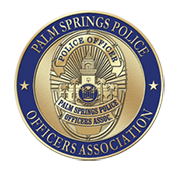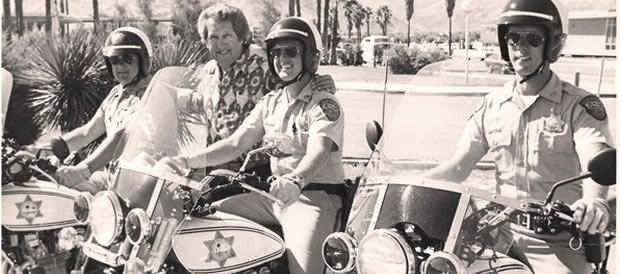About the PSPOA
The PSPOA Has a Proud Tradition of Service to Palm Springs and the PSPD
THE EARLY YEARS
The City of Palm Springs was incorporated in 1938.
The Police Department was operating as a Police Protection District with four officers.
- J.Lloyd Boller was Chief of Police from 1938 to 1939.
- From 1939 to 1940 the Department was headed by W. H. BISPHAM.
No Radios
- Officers were notified of an assignment by looking up, or down, Palm Canyon Drive to a red light suspended by wire across the street. If the light was on, the officer called the Station to get his message.
The City purchased the District in 1940 and on October 30, 1940 there was an official Palm Springs Police Department.
- The City began paying the Chief, Officers and other employees.
- The population of the city was less than 2000.
The Department consisted of the following personnel:
- Chief Norman Harstad (1940-1941) @ $300 per mo.
- A Sergeant @ $175 per mo.
- 5 Patrol Officers @ $150 per mo.
- 2 Clerk/Dispatchers @ $150 per mo.
- A car and radio were purchased outright and motor officer and motorcycle were financed by donations.
The City closed down sometime between Easter and June 1st. It came back to life around October 1st. Because the City Fathers could not justify salaries for full time officers until Autumn, a skeleton crew worked the summer months.
The majority of officers were seasonal. As the demand for police decreased in Palm Springs during the summer months, it increased in resorts like Catalina, Avalon, Laguna Beach and Lake Tahoe. It was not unusual to see Palm Springs' finest working in these cities for the summer.
There was one fringe benefit that all city employees received, regardless of seniority: 30 days paid vacation. This was justified by local doctors who recommended getting out of the heat and dryness of the desert, for health reasons. This was discontinued about 1960.
The first Police building was located on North Palm Canyon. The village was too small for addresses. But, it was located roughly where the Lobster Company restaurant is now.
By 1947 the Department had grown to 17 employees. Under the direction of Chief August "Gus" Kettmann, (4/1/45 - 2/28/53 and 1/17/55 - 6/14/64), the Department had a budget of $55,000. Orest Johnson was Acting Chief of Police during Kettmann's absence.
The building was eventually numbered 381 N. Palm Canyon. The building was a combination Fire House and Police Department. The fire portion of the building was two stories with a dormitory on top and an apparatus room below.The Police Department consisted of the following:
- Juvenile Office
- Vice and Narcotics Office
- General Investigations Office containing one desk shared by 4 Detectives, 1 drawer each.
- Two cells and a Drunk Tank surrounded by a combination locker/briefing/report writing room.
- Chief's Office
- Captain's Office
- Watch Commander's Office/Reception Area/Records/Communications room completed the facility.
ALL OF THIS IN 2300 SQUARE FEET!
1957
- The Department now had 47 members and for the first time Chief of Police August "Gus" Kettmann allowed heaters to be installed in the patrol cars, 1957 Ford Interceptors. There were six patrol cars and 4 unmarked cars, three motorcycles and a parking control utility cycle.
- Several more years would pass before the Chief would allow air conditioning.
1959
- P.D. moved to a new building at 3111 Tahquitz-McCallum Way. The new building was 13,400 sq. feet. It was projected that it would accommodate the department for decades of use. However, after just one decade it was in need of expansion.
1970
- The department consisted of 76 employees: a Chief, three Captains, six Lieutenants, seven Sergeants and 36 officers, one of which was a police woman.
- There were 21 classified employees (Dispatchers, Clerks, Animal Control Officers, Lab Technicians and Secretaries). In less than 7 years, the sworn ranks of the department would grow by 30 members to 83.
1972
- The building was expanded to the East and a new detective office intended for the general investigative unit was completed. Over the next few years the gym was divided to make new office space for Vice and Narcotics and the briefing/class room was partitioned for more office space.
1977
- The Training Center was built. It included a library, three class rooms and an indoor range facility. The two offices were occupied by Planning and Research, and Personnel and Training. In 1978, Planning and Research was eliminated as a result of the passage of prop. 13's tax initiative.
1985
- A new police facility just south of the Training Center was completed. The P.D. moved into a 43,000 sq. ft. building with planned room for expansion.
1995
- The Department consists of 78 officers and 46 classified employees.
- 61 people are assigned to Operations/Patrol
- 60 are assigned to support Services and 3 in Animal Control.
- 43 officers respond to calls for services; they are spread over 4 shifts
- The police fleet consists of more than 50 vehicles.
2004
- The Department consists of 88 officers and 59.5 classified employees.
- 54 officers in Patrol Operations
- 23 officers in Investigations Bureau
- 5 officers in Administration (includes School Resource Officer and Family Intervention Officers)
CHIEFS OF POLICE
There have been eleven Chiefs of Police since 1940.
- Norman Harstad 1940 (w/out pay) - 1941 (w/pay)
- Lyle Sanard 1941 - 1945
- August Kettmann 4/1/45 - 2/28/53
- Orest Johnson (acting) 2/28/53 - 1/17/55
- August Kettmann 1/17/55 - 6/14/64
Responsible for the implementing Police Reserves and the Mounted Police - Orest Johnson 6/16/64 - 6/30/68
- Robert "Bob" White 7/1/68 - 11/30/77
The department grew to present size. Built Training Center and instituted: Aero Squadron, Crime Prevention Detail, Youth Service Team, Downtown Foot Patrol - Thomas Kendra 12/1/77 - 10/7/89
Instituted: new Crime Prevention Unit, (we began recognizing the value in using classified employees in what had been traditional police roles), Public Information Officer (press liaison), Crime Stoppers Program, SWAT Team, K-9 Unit; Built the current building - Donald J. Burnett 10/16/89 - 12/27/93
Instituted: Youth Court, Downtown Bicycle Patrol, Citizens Police Academy - Bill Valkenburg 12/26/93 - 1/23/95
Uniform change from tan to blue - Gene Kulander 1/23/95 - 7/23/97
Police Activities League; Yearly Police Department Open House - C. Lee Weigel 6/23/97 – 6/30/02
Implemented Citizens on Patrol program; Downtown Experience Office in the downtown area; joint narcotics task forces. Implemented the cameras in the downtown area and really brought community policing and put it into practice in Palm Springs. - Gary Jeandron 7/1/02 – 12/31/07
Conducted fundraising, artist selection, building and dedication of the Police Memorial Plaza. It was his dream that our fallen officers be remembered; a goal he envisioned and saw to fruition. He increased manning and supported many community policing programs. - Michael Hall (Acting) 1/1/08 – 2/3/08
- David Dominguez 2/4/08 - 05/11
- Alberto Franz III 06/16/11 - 12/18/2015
- Bryan Reyes (Interim Chief) 12/20/15 - 12/11/16
- Bryan Reyes 02/11/16 - 08/23/21
- Melissa Desmarais (Interim Chief) 08/23/21 - 11/06/21
- Andrew G. Mills 11/07/21 - current


